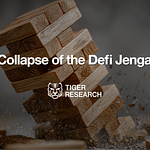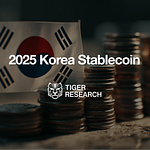Tiger Research analyzes how Vietnamese users have created a parallel financial system through stablecoin adoption.
TL;DR
Stablecoins operate as an independent financial rail in Vietnam. They facilitate trading, remittances, and serve as a store of value beyond traditional banking systems and government oversight.
Vietnamese users routinely access stablecoins through unofficial channels. The government maintains a strict ban and has not initiated meaningful policy discussions about stablecoins.
Vietnam should formally integrate stablecoins into its financial system. Aligning policy with market realities will strengthen Vietnam's competitive position in Southeast Asia's digital finance sector.
1. Stablecoin Market Growth Amid Regulatory Disconnect
Vietnam consistently ranks at the top of global cryptocurrency adoption indices. However, the lack of a clear regulatory framework limits industry development in the country. Despite these constraints, Vietnam's cryptocurrency industry grows rapidly with retail users leading the way. Within this growth, the stablecoin market has begun to emerge. Vietnamese users actively trade stablecoins through various methods despite having no official on-ramp and off-ramp channels. They use escrow transactions via Binance P2P services, engage in OTC trading through Telegram channels, and perform direct P2P exchanges using self-custody wallets.
This retail-centered organic growth faces clear long-term limitations. The absence of regulation reduces market transparency and stability. The market cannot sustain continuous development with only retail users due to significant potential risks and constraints. Vietnam has neither established legal and institutional foundations for stablecoins nor engaged in substantive policy discussions. This disconnect between market reality and regulation amplifies potential risks in Vietnam's financial market. It also causes the country to miss strategic opportunities that could enhance national competitiveness.
This report analyzes how Vietnamese users utilize stablecoins in their actual financial activities, including trading, peer-to-peer remittances, and payments. It examines the potential risks created by regulatory gaps. The report also explores the necessity of developing stablecoin policies based on users' actual financial behavior and identifies the strategic opportunities these policies could create.
2. Stablecoins Already Fit Vietnamese Behavior
2.1. Trading and Liquidity Management
Vietnamese cryptocurrency investors use stablecoins for purposes beyond exchanging fiat currency and cryptocurrencies. Investors hold funds in stablecoins (primarily USDT) instead of immediately converting back to Vietnamese dong (VND) after trading. They utilize these holdings as reserves for future trades. They also use them as digital safe assets against market volatility. This behavior shows Vietnamese cryptocurrency investors now actively manage liquidity through stablecoins, a significant change from past practices.
When cryptocurrency markets decline, Vietnamese investors convert their funds to USDT rather than off-ramping to fiat currency. During periods of high market volatility, USDT prices on Binance P2P markets rose to 25,000-27,000 VND, up to 5% higher than normal rates, creating significant premiums. This premium demonstrates that investors view stablecoins as independent stores of value and safe-haven assets separate from other cryptocurrency market assets. Consequently, stablecoins have established themselves as essential liquidity management tools in Vietnam's cryptocurrency market.
This phenomenon represents a consistent trend rather than a temporary anomaly. From 2020 to 2025 (excluding exceptional events like the FTX and Terra-Luna collapses), USDT prices in Vietnam maintained consistent premiums above the official VND/USD exchange rate. The average premium reached 3.35% in 2024. Vietnamese investors willingly pay additional costs to actively manage financial market volatility and exchange rate risks through stablecoins.
Complex procedures and strict regulations in Vietnam's financial system drive this behavior. Vietnamese banks enforce strict regulations on fund sources and transaction purposes. Investors encounter significant inconvenience and costs when they withdraw or transfer funds through banks. To avoid these regulatory risks and costs, investors have established independent fund management systems centered around stablecoins within the cryptocurrency ecosystem. This explains why stablecoins have become essential financial instruments in Vietnamese investors' portfolios.
2.2. Peer-to-Peer Transfers: Stablecoins as Payment Infrastructure
Stablecoins actively serve as peer-to-peer payment and remittance tools within Vietnam. Using cryptocurrencies as payment instruments remains illegal in Vietnam. Despite this, users conduct transactions outside the formal system through personal wallet transfers and unofficial OTC channels. Vietnam ranks among the top five countries globally for receiving remittances through stablecoins. Approximately 7.8% of all foreign remittances entering Vietnam arrive in the form of stablecoins like USDT.
Traditional foreign remittance methods such as SWIFT or Western Union charge high fees of 5-7% and require several days for processing. Stablecoin transfers complete within minutes without intermediary fees. These advantages make stablecoins an efficient remittance alternative for overseas workers and freelancers. E-commerce operators, dropshipping businesses, and freelancers frequently pay in USDT through Telegram or social platforms.
This peer-to-peer stablecoin transaction method digitally recreates the informal cash-based system that has long supported Vietnam's retail and remittance economy. This payment method thrives in online environments and rapidly spreads as a cross-border transaction medium.
2.3. Stablecoins as Stores of Value
Vietnamese citizens traditionally prefer safe-haven assets like physical gold or US dollars during periods of high inflation or exchange rate volatility. Gold preference stands out particularly. Vietnamese households purchase approximately 50-60 tons of gold annually, with projections indicating an increase to 70-80 tons within the next five years. In mid-2024, Vietnamese banks sold over 2 tons of gold in just one week despite high gold prices. This demonstrates how ordinary households with limited access to financial services actively use gold as a long-term store of value rather than for short-term speculation.
Recently, stablecoins have emerged as new digital safe-haven assets that complement or replace traditional assets like gold or dollars. Stablecoins such as USDT or USDC function as digital dollars and provide stable value preservation similar to gold or physical dollars. Using cryptocurrencies as payment instruments remains illegal in Vietnam. Despite this, an increasing number of users hold stablecoins purely to maintain stable asset value rather than for trading or payment purposes. This clearly demonstrates that stablecoins serve as stores of value within Vietnam.
3. The Way Forward for Vietnam's Government: Regulation Reflecting Market Realities
In Vietnam, stablecoins have naturally grown outside the formal financial system and established themselves as an important pillar of 'shadow finance.' Investors widely use them not only as primary liquidity management tools but also for peer-to-peer payments and as stores of value.
The Vietnamese government recently acknowledged the importance of the cryptocurrency industry and prepares related legal frameworks and regulatory sandboxes. However, Vietnam still lacks specific and substantive discussions about stablecoins that see active use in the market. As Prime Minister Pham Minh Chinh recently emphasized, "What is not prohibited by law should be available to citizens and businesses, and the state should not intervene in areas where they can perform better." This suggests a market-friendly approach would serve better than simple regulation. Policies that consider users' actual usage patterns and safely integrate them into the formal system can achieve balance between innovation and regulation.
3.1. Lessons from Neighboring Southeast Asian Countries
While Vietnam struggles to establish clear regulations for stablecoins, neighboring Southeast Asian countries have already built regulatory frameworks that reflect market realities. Unlike Vietnam's bureaucratic approach of "regulate what you don't understand, ban what you can't manage," surrounding countries implement practical policies tailored to their specific situations.
Singapore chose a systematic institutional approach. In its stablecoin regulatory framework introduced in 2023, the Monetary Authority of Singapore (MAS) specified 1:1 reserve requirements, daily value disclosure obligations, and guaranteed par value redemptions. By allowing only authorized issuers to issue stablecoins, Singapore enhances the credibility of its digital asset market.
Thailand adopted a more flexible dual-track system. In March 2025, regulators permitted USDT and USDC use on authorized exchanges while simultaneously conducting pilot projects for baht-pegged stablecoins backed by government bonds. This approach seeks balance by recognizing the utility of foreign stablecoins while gradually developing domestic currency instruments.
The Philippines emphasizes experimentation and practicality. The Bangko Sentral ng Pilipinas (BSP) and Securities and Exchange Commission (SEC) launched pilot projects like PHPC for remittances, prioritizing practical implementation over complex pre-legislation. They take a pragmatic approach by actively utilizing regulatory sandboxes, particularly in cross-border payment areas.
While these countries build regulatory frameworks suited to their environments and user needs, Vietnam has yet to establish a stablecoin-specific regulatory framework. This widens the gap between actual market usage and regulation.
An important lesson from neighboring countries reveals the need to establish regulations that reflect actual usage patterns in the domestic market rather than simply adopting foreign models. If Vietnam fails to develop a regulatory framework that reflects these market realities, informal financial channels will become more entrenched outside the formal system, creating long-term difficulties in financial supervision and monetary policy operations.
3.2. Building a Stablecoin Strategy Based on Vietnam's Market Realities
Vietnamese retail users already participate in various financial transactions using stablecoins, particularly dollar-based USDT, as part of their daily routines. Therefore, policymakers need to adopt an approach that considers these market realities and develop policies through active communication with market participants rather than imposing unilateral controls.
For example, instead of forcing a top-down approach with limited usability like the Central Bank Digital Currency (CBDC), Vietnam could more effectively design a bottom-up regulatory model based on already established user behavior patterns. This would allow regulations to reflect actual market activities and enhance policy effectiveness.
Specific measures the Vietnamese government could consider include:
Increasing transparency in informal channels through OTC broker certification, appropriate KYC systems, and systematic approaches to P2P stablecoin trading systems
Operating regulatory sandboxes for VND-pegged stablecoins targeting limited sectors such as e-commerce, foreign remittances, and freelance markets
Providing user-friendly alternatives that comply with regulations while competing with dollar-based stablecoins
This approach will harmonize organic market development with regulatory stability. If Vietnam proactively responds to changes in the digital financial environment, it can build a more transparent and secure stablecoin ecosystem.
4. Closing Thoughts
Vietnam's stablecoin ecosystem formed naturally in response to users' practical needs rather than government policies or regulations. Vietnamese users created independent financial rails in an environment without official cryptocurrency trading channels. They trade USDT, send remittances through Telegram OTC, and store value in digital dollars. This represents a practical solution where the market filled gaps in the official financial system.
Users initially perceived stablecoins as temporary workarounds to bypass existing financial systems. Now these digital assets serve as an important foundation for Vietnam's digital financial ecosystem. Users have already normalized stablecoins in their daily financial activities without waiting for official regulations or legal recognition. However, the continuation of these financial activities without legal clarity risks pushing them into informal and opaque areas. This could potentially intensify financial market distortion and instability.
Neighboring countries like Singapore and Thailand actively embrace user behaviors already established in the market. They create systematic regulatory environments that balance innovation and stability. Vietnam also needs to build a regulatory framework that considers market realities. It should officially recognize user-created informal financial channels and strengthen its financial infrastructure through VND-based stablecoins. Through this user-centered approach, Vietnam can enhance financial market transparency and stability. It can also secure a leading position in digital asset governance in Southeast Asia.
🐯 More from Tiger Research
Read more reports related to this research.[Special Report] APAC Web 3 Powerhouse : Inside Vietnam's Blockchain Market
Vietnam's Crypto Regulation: From Regulatory Gray Zone to Controlled Experimentation
Disclaimer
This report has been prepared based on materials believed to be reliable. However, we do not expressly or impliedly warrant the accuracy, completeness, and suitability of the information. We disclaim any liability for any losses arising from the use of this report or its contents. The conclusions and recommendations in this report are based on information available at the time of preparation and are subject to change without notice. All projects, estimates, forecasts, objectives, opinions, and views expressed in this report are subject to change without notice and may differ from or be contrary to the opinions of others or other organizations.
This document is for informational purposes only and should not be considered legal, business, investment, or tax advice. Any references to securities or digital assets are for illustrative purposes only and do not constitute an investment recommendation or an offer to provide investment advisory services. This material is not directed at investors or potential investors.
Terms of Usage
Tiger Research allows the fair use of its reports. ‘Fair use’ is a principle that broadly permits the use of specific content for public interest purposes, as long as it doesn't harm the commercial value of the material. If the use aligns with the purpose of fair use, the reports can be utilized without prior permission. However, when citing Tiger Research's reports, it is mandatory to 1) clearly state 'Tiger Research' as the source, 2) include the Tiger Research logo(Black/White). If the material is to be restructured and published, separate negotiations are required. Unauthorized use of the reports may result in legal action.

















